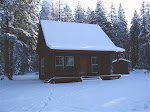
 The main frame/chassis/undercarriage is brought in at one end of the factory.
The main frame/chassis/undercarriage is brought in at one end of the factory.The floor assembly is based on an aluminum frame enclosing foam insulation, with 5/8” plywood screwed to the frame and linoleum laminated on top. The chassis is then flipped upside down, and the axles, wheels, and underside wiring, plumbing, and heating ducts are installed on the bottom side of the chassis. In some models extra insulation and heating ducts are added to aide in winter camping. This mess is then covered with a layer of corrugated plastic material which encloses the bottom side, keep out some cold and helping
to reduce wind drag.
The trailer is then flipped back upright for the construction phase. At this point the interior walls, cabinets, framing are installed onto the floor. These elements are screwed down to the
plywood floor. Next, kitchen and bath components are installed into the trailer and plumbed in. Wiring to the cabinets and lighting, and plumbing is completed to the sinks, shower and toilet.


Once the interior items are installed, the walls can be erected onto the floor. The front, rear and side walls are built separately, based on a framing made from 2” square tubular aluminum material.

Rigid foam insulation is cut to fit inside the frame and layers of fiberglass is laminated to the outside of the frame. Luan plywood and a layer of laminate material is laminated to the inside, completing a one-piece wall assembly. The wall is then lifted into place and screwed down to the floor. The other three walls are built and attached in the same manner.

An aluminum framed roof assembly is built similarly to the walls, but in many cases, could have either a flat roof or arched steel trusses to create curved roof. The roof is covered with EPDM rubber which us glued down to make itwaterproof. Roof vents and an air conditioner is added and screwed down and sealed.

Slide outs are assembled separately and mounted to the trailer.
Doors and windows are installed and sealed.
Graphics are placed on the walls.
Doors and windows are installed and sealed.
Graphics are placed on the walls.

Meanwhile, people are com
pleting the interior, mounting and wiring the electrical panel, lighting, heating, microwave, oven, televisions, mirrors, drawers, cushions, and carpets.
Once the trailer is complete, a quality assurance inspector goes over the inside and out, marking anything that isn't correct with pieces of red tape. Cabinets, marks, scratches, etc. Then someone goes back in and corrects the defects.
Once the trailer is complete, a quality assurance inspector goes over the inside and out, marking anything that isn't correct with pieces of red tape. Cabinets, marks, scratches, etc. Then someone goes back in and corrects the defects.

No comments:
Post a Comment